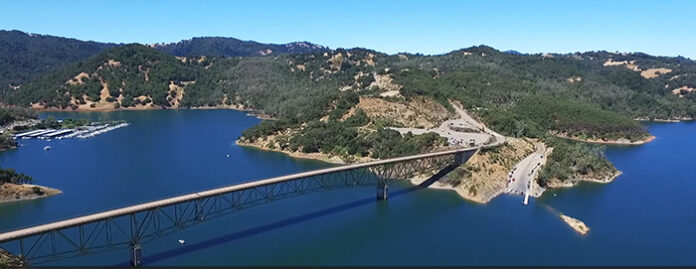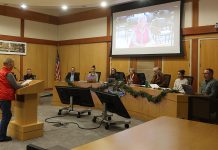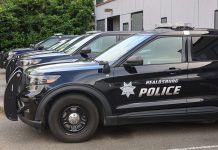
The sidewalks from last week’s deluge had barely time to dry when the City of Healdsburg on Monday night lifted mandatory water conservation policies, imposed almost three years ago to combat the drought that has afflicted Sonoma County and the rest of California.
The policies were related to Stage 2 Mandatory Water Shortage Requirements, which required a 20% reduction in water use from residents and businesses in city limits. The city had at one time been under Stage 3 water use restrictions of 40% due to “extreme drought conditions,” per the state of California.
After early rains in the fall of 2021, the City reduced mandatory water restrictions back to Stage 2 to target a 20% reduction in water usage.
Healdsburg was one of the most successful communities in the state at reducing water usage, far above the 20% requirement, to almost 35% reduction in water usage overall. That success was qualified however by the fact that water use per capita in Healdsburg has historically been high, according to Utility Director Terry Crowley’s report to the city council.
However, on March 24—thanks to abundant and record rainfall across the state—the governor’s office all but announced the drought was over, repealing the statewide requirement for a voluntary 15% reduction in water use, and the requirement that municipal water suppliers (such as Healdsburg) hold at Stage 2.
Starting during the summer of 2020 and lasting through the fall of 2022, Sonoma and Mendocino counties experienced prolonged and historic drought conditions. These conditions depleted water storage in Lake Mendocino and Lake Sonoma, requiring the City to implement mandatory water conservation measures.
The last few months have brought near-record rainfall to Sonoma County and Healdsburg, filling the two Russian River reservoirs to their limit. Lake Sonoma, which on Oct. 1, 2022 contained only 42% of storage capacity, now sits at over 106%. Six months ago, Lake Mendocino held only 36% of capacity; now it’s over 99%.
Cumulative rainfall totals in the area generally put the year-to-date total at about 50 inches, almost 15 inches in March alone, though there’s a range of numbers from different locations. The rainfall year is marked from Oct. 1 to Sept. 30, the months of most seasonal precipitation.
The long and the short of it: Due to increases in stored water and Gov. Gavin Newson’s recent Executive Order lifting statewide requirements, the City of Healdsburg no longer has either the supply shortage or the provision “that requires mandatory conservation measures,” according to the report presented to the City Council at their April 3 meeting.
But as director Crowley said at Monday’s meeting, “There are still state requirements for not wasting water. Those are pretty simple things, common sense you know—not over-spraying on the sidewalks, not over irrigating so much that you have runoff, not washing a car with a hose that doesn’t have an automatic shutoff valve…”
Other state limitations prohibit outdoor watering within 48 hours after one quarter inch or more of rainfall; and no washing of hard surfaces like driveways or sidewalks that do not absorb water, as well as several restrictions on the public use of water for decorative purposes, such as lawns or fountains.
Added Crowley, “We will continue to reach out to the community and educate them about the safe use of water, or the conscious use of water, through the summer, as we go into irrigation season. So it’s not that we’re looking forward to the next drought, but we need to plan ahead for that.”
The city’s website has an April 4 “news flash” or FAQ on the rescinding of the restrictions, at healdsburg.gov/CivicAlerts.aspx?AID=627. It states, “Historically, Healdsburg used about 50% more water per capita than other cities in the County prior to the 2021 drought. While consumption was higher than other cities in the region before the drought, Healdsburg residents have made substantial reductions in their water usage during the drought.”
Additional city information on conservation is found at smartlivinghealdsburg.org.








